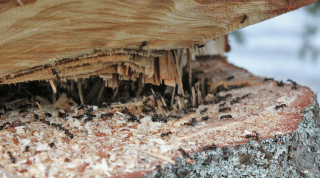Ants are fascinating insects with their organized colonies and efficient teamwork. Still, they can pose a threat to the health of your trees. This article will explore the question, "Can ants kill a tree?" and provide insights on identifying ant infestations in trees and how to eliminate them effectively. Strobert Tree Services, a leading tree care provider in Delaware, Pennsylvania, Maryland, and New Jersey, offers expert guidance on maintaining the health and vitality of your trees.
Signs of Ant Infestation in Your Tree
Before delving into whether ants can kill a tree, it's crucial to recognize the signs of ant infestation. Like other living organisms, trees can fall victim to various pests, and ants are no exception. Here are common indicators that your tree might be hosting an ant colony:
- Unexplained Leaf Damage: Ants, particularly certain species, can cause damage to leaves as they feed on the sap. It could be a sign of ant activity if you notice unexplained browning, wilting, or holes in your tree's leaves.
- Ant Trails: If you observe visible trails of ants climbing up and down the trunk or branches of your tree, it's a clear indication of their presence. These trails are often formed as ants navigate between their nest and foraging areas.
- Sawdust Around Tree Base: Some ant species, such as carpenter ants, create nests within trees by tunneling through the wood. If you notice sawdust accumulating around the base of your tree, it may suggest a carpenter ant infestation.
What Kind of Ants Live in Trees?
Not all ants pose a threat to trees, but certain species are known to inhabit and potentially harm them. Two common tree-dwelling ant species to be aware of are:
- Red Imported Fire Ants: These aggressive ants are notorious for their painful stings and ability to damage trees. They often build nests in soil, creating large mounds near tree bases.
- Carpenter Ants: As their name suggests, carpenter ants tunnel through wood to create nests. While they don't consume wood like termites, their activity can weaken the structure of a tree over time.
How to Remove Ants from Trees
Now that we've identified the signs of ant infestation and the types of ants that may threaten your trees, it's crucial to address the issue promptly. Here are practical steps to remove ants from your trees:
- Identification of Ant Species: Before implementing any control measures, it's essential to identify the ant species infesting your tree. Different species may require specific approaches for effective removal.
- Natural Predators: Encourage the presence of natural ant predators, such as ladybugs and predatory beetles, in your garden. These insects can help keep ant populations in check without harming your trees.
- Ant Baits: Use ant baits strategically placed around the tree's base. These baits contain toxins that ants carry back to the colony, eliminating the entire nest.
- Trimming Branches: Trim any branches that come into direct contact with your home or other structures. Carpenter ants often use tree branches as a bridge to access buildings.
- Professional Tree Care Services: In severe cases of ant infestation or if you are unsure about the best course of action, seeking professional assistance is advisable. Strobert Tree Services, with its extensive experience in tree care, can assess the situation and provide targeted solutions to protect your trees.
Contact Strobert Tree Services
When it comes to the health and well-being of your trees, it's essential to consult with experts who understand the intricacies of tree care. Strobert Tree Services stands out as a leader in tree care across Delaware, Pennsylvania, Maryland, and New Jersey. With a team of skilled arborists, Strobert Tree Services offers comprehensive solutions to address ant infestations and ensure the longevity of your trees.
While ants can threaten trees under certain circumstances, proactive measures and professional tree care services can effectively mitigate the risks. By staying vigilant and taking prompt action, you can protect your trees from potential harm and ensure they thrive for years.











